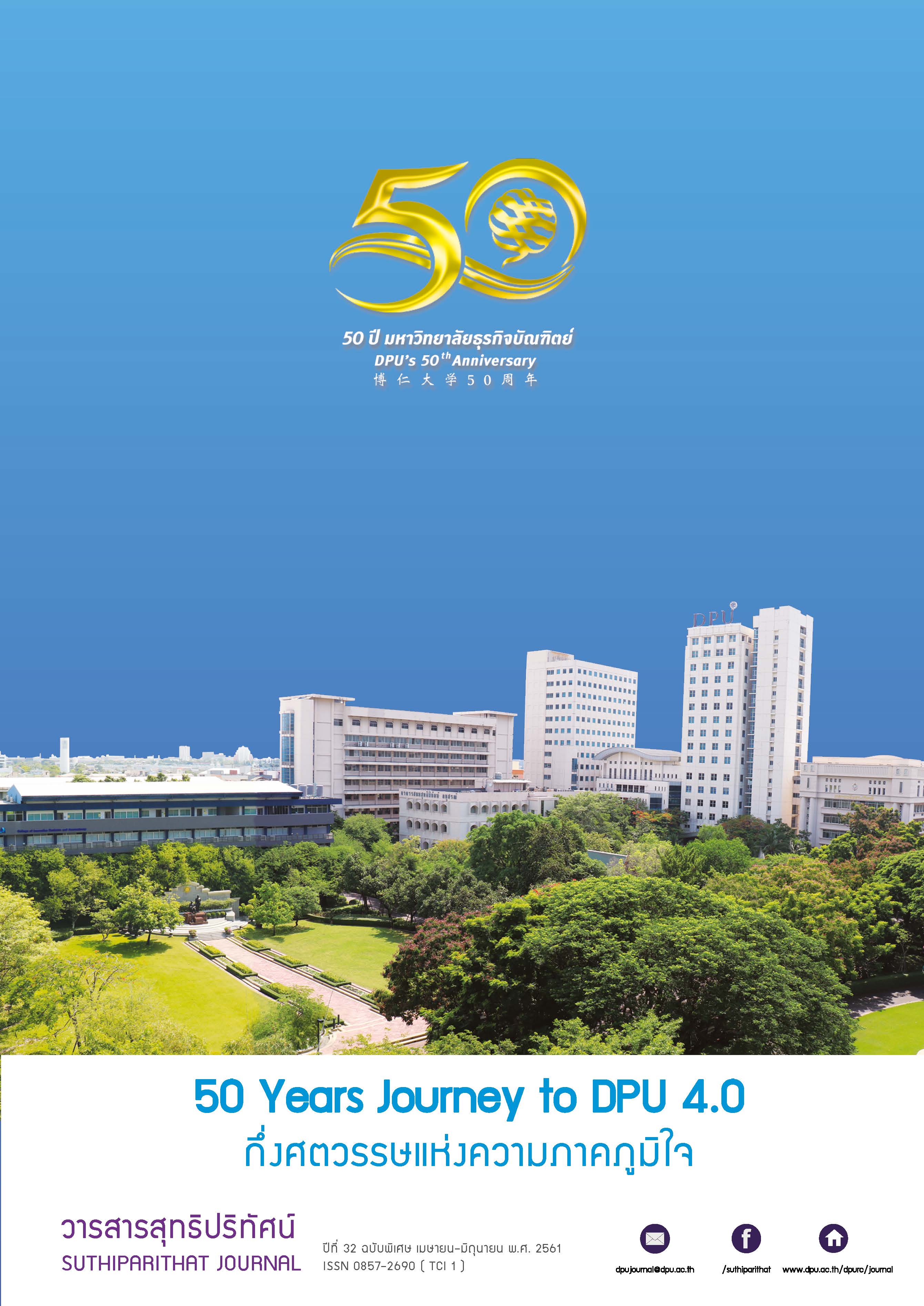การเสริมสร้างสมรรถนะในการสื่อสารระหว่างวัฒนธรรม เพื่อทักษะการสื่อสารอย่างมีประสิทธิภาพในชั้นเรียนภาษาอังกฤษเพื่อจุดประสงค์เฉพาะ
คำสำคัญ:
การวิเคราะห์สถานการณ์ ในการสื่อสารระหว่างวัฒนธรรม, ภาษาอังกฤษเพื่อจุดประสงค์เฉพาะ, ผู้ที่มีสมรรถนะในการสื่อสารระหว่างวัฒนธรรม, ความตระหนักรู้เรื่องประเด็นระหว่างวัฒนธรรมสมรรถนะในการสื่อสารระหว่างวัฒนธรรมบทคัดย่อ
บทความนี้มุ่งเน้นให้เห็นความจำเป็นในการสร้างความตระหนักรู้เรื่องประเด็นระหว่างวัฒนธรรมให้กับนักศึกษาในสาขาวิชาต่างๆ และความจำเป็นในการเสริมสร้างทักษะการสื่อสารระหว่างวัฒนธรรมในการเรียน การสอนรายวิชาภาษาอังกฤษเพื่อจุดประสงค์เฉพาะ ทั้งนี้ การสร้างความตระหนักรู้และการเสริมสร้างทักษะ ดังกล่าวเป็นเรื่องที่ท้าทายและต้องอาศัยความพยายามอย่างยิ่งสำหรับผู้สอนรายวิชาภาษาอังกฤษเพื่อจุดประสงค์เฉพาะ เนื่องด้วยผู้สอนนั้นมีบทบาทสำคัญในการช่วยให้ผู้เรียนมีความตระหนักรู้และมีทักษะทางด้านการสื่อสารระหว่างวัฒนธรรม เพื่อที่ผู้เรียนจะสามารถสื่อสารได้อย่างมีประสิทธิภาพเมื่อไปประกอบวิชาชีพในสังคมโลกาภิวัตน์ ดังนั้น บทความนี้จึงได้อธิบายเรื่องสมรรถนะในการสื่อสารระหว่างวัฒนธรรมในบริบทการทำงานในสังคมโลกาภิวัฒน์ ในแง่ขององค์ประกอบในการสื่อสารระหว่างวัฒนธรรม และสัดส่วนของเนื้อหาทางด้านการสื่อสารระหว่าง วัฒนธรรมในตำราสอนภาษาอังกฤษเพื่อจุดประสงค์เฉพาะทุกสาขาวิชาที่มีวางจำหน่ายอยู่นอกจากนั้น บทความ นี้ยังได้นำเสนอแนวทางการแสวงหาข้อมูลต่างๆ เพื่อสร้างและพัฒนารายวิชาภาษาอังกฤษเพื่อจุดประสงค์เฉพาะ โดยใช้การวิเคราะห์สถานการณ์ในการสื่อสารระหว่างวัฒนธรรม แนวทางการสอดแทรกองค์ประกอบทางด้านการ สื่อสารระหว่างวัฒนธรรมในเอกสารหรือตำราที่ใช้ในการเรียนการสอน แนวทางการใช้และประยุกต์ใช้แนวการสอน และกิจกรรมต่างๆในห้องเรียนที่มีเนื้อหาเกี่ยวกับการสื่อสารระหว่างวัฒนธรรม โดยมีอาจารย์ผู้สอนรับบทบาทใน การอำนวยความสะดวกในกระบวนการเรียนการสอน รวมถึงแนวทางการใช้เครื่องมือในการประเมินผลเพื่อวัดประสิทธิภาพของการสอนและประเมินสมรรถนะทางด้านการสื่อสารระหว่างวัฒนธรรมของผู้เรียน ในบทสรุปนั้น ได้มีข้อเสนอแนะเพื่อเป็นแนวทางในการพัฒนาเอกสารหรือตำราที่ใช้ในการเรียนการสอนและการพัฒนารูปแบบ การเรียนการสอนรายวิชาภาษาอังกฤษเพื่อจุดประสงค์เฉพาะ รวมถึงยังได้ชี้ให้เห็นบทบาทของสมรรถนะในการสื่อสารระหว่างวัฒนธรรมที่มีต่อการได้งานทำของบัณฑิตในตลาดแรงงานนานาชาติ
เอกสารอ้างอิง
Ala-Louko, R. (2017). Developing international competence and intercultural communication skills is an investment in the future. Retrieved January 1, 2018, from https://www.theseus.fi/bitstream/handle/10024/133868/d%20Intercultural%20Communication%20Skills%20is%20an%20Investment%20in%20the%20Future%20Ritva%20Ala-Louko%20Lumen%202_2017.pdf?sequence=1
Blockmans, I. G., Dyk, T. V., Gasiorek, J.,& Poel, K. V. D. (2015). A needs analysis for communication by pharmacists in a multilingual setting: First steps towards syllabus and materials design. Retrieved December 3, 2017, from https://www.ajol.info/index.php/spl/article/view/133806/123415
Brown, D. B. & Martindale, T. (2013). A review of intercultural training in the workplace. Retrieved January 2, 2018, from https://members.aect.org/pdf/Proceedings/proceedings12/2012i/12_03.pdf
Candel-Mora, M. A. (2015). Attitudes towards intercultural communicative competence of English for specific purposes students. Retrieved November 25, 2017, from https://www.sciencedirect.com/science/article/pii/S1877042815019345
Candel-Mora, M. A. (2015). Benchmarking intercultural communication competence assessment tools for ESP teaching. ELIA, 15, 93-107.
Constantin, E. & Molea, A. (2014). Intercultural perspectives on ESP. SYNERGY, 10(1),136-145.
Connor, U. & Traversa, A. (2013). The Role of intercultural rhetoric in ESP education. Retrieved December 15, 2017, from http://www.nus.edu.sg/celc/research/books/4th%20Symposium%20proceedings/3).%20Connor%20and%20Traversa.pdf
Corballis, T. & Jennings, W. (2009). English for management studies in higher education studies. Reading: Garnet Publishing.
Dabaghi, A. & Heidari, A. (2015). Cross-cultural metaphor awareness as a key component in intercultural communication competence. Retrieved December 18, 2017, from https://www.immi.se/intercultural/nr37/heidari.html
Dudley-Evans, T. & St John, M. J. (1998). Developments in English for Specific Purposes: A multi-disciplinary approach. Cambridge: Cambridge University Press.
Emery, H. & Roberts, A. (2008). Aviation English for ICAO compliance. Oxford: Macmillan Education.
Ennser-Kananen, J. (2016). A pedagogy of pain: New directions for world language education. The Modern Language Journal, 100(2), 557-558.
Glendinning, E. H. & Holmstrom, B. A. S. (2005). English in medicine. Cambridge: Cambridge University Press.
Hazrati, A. (2014). Intercultural communication and discourse analysis: The case of aviation English. Retrieved January 20, 2018, from http://aviationenglishacademy.com.au/resources/wp-content/uploads/2015/09/1-s2.0-S1877042815035065-main.pdf
Hollett, V. & Sydes, J. (2009). Tech talk. Oxford: Oxford University Press.
Jendrych, E. (2011). New approach to teaching English for business communication. Retrieved November 28, 2017,from http://sunisamay.wikispaces.com/file/view/ContentServer.....pdf/355026210/ContentServer.....pdf
Kavalir, M. (2013). Culture in ESP syllabus: Why and how. Romanian Journal of English Studies, 10(1), 113-122.
Kehagia, O & Nteliou, E. (2016). Intercultural perceptions among undergraduate students in English for business and economics courses. International Journal of Language, Translation and Intercultural Communication,4(1), 98-109.
Lazar, T. (2017). Some sources of misunderstandings in intercultural business communication. International Journal of Engineering and Management Sciences (IJEMS),2(3), 91-101.
Liton, H. A. (2016). Adopting intercultural communication issue in teaching English. Lingua Cultura, 10(1),1-6.
Liton, H. A. & Qaid, A. S. A. (2016). Addressing intercultural communication issue in teaching English. International Journal of Humanities and Applied Sciences (IJHAS), 5(1), 40-44.
Liu, X. & Zhu, W. (2016). Towards an integrated approach to cabin service English curriculum design: A case study of China Southern Airlines’ cabin service English training course. Higher Education Studies, 6(2), 30-38.
Loukianenko, M. (2004). The cross-cultural component in teaching business English to native Russian speakers. Retrieved January 13, 2018, fromhttps://lib.dr.iastate.edu/cgi/viewcontent.cgi?article=17158&context=rtd
McCullagh, M. & Wright, R. (2008). Communication skills in English for the medical practitioner. Cambridge: Cambridge University Press.
Mol, H. (2008). English for tourism and hospitality in higher education studies. Reading: Garnet Publishing.
Moore, B. (2013). Discovering the Language Needs of Hotel Workers in Thailand. Thammasat Journal, 31(2), 1-12.
Negrea, V. (2015). ESP: Linguistic and cross-culture competence through blended learning. Retrieved October 27, 2017, from http://www.utgjiu.ro/revista/lit/pdf/2015-04/01_Negrea.pdf
O’Connell, S. (2014). University curriculum globalization: Developing intercultural business communication and understanding courses at a Japanese university. Retrieved December 22, 2017, from https://www.fas.nus.edu.sg/cls/CLaSIC/clasic2014/Proceedings/o%27connell_sean.pdf
Semenchuk, Y. (2015). Pedagogical implications on interactive techniques of teaching non-linguistic students economic terminology. Retrieved December 30, 2017, from https://www.ajol.info/index.php/rje/article/viewFile/128009/117559
Shawcross, P. (2011). Flightpath: Aviation English for pilots and ATCOs. Cambridge: Cambridge University Press.
Songhori, M. H. (2008). Introduction to needs analysis. Retrieved October 26, 2017, from http://www.esp-world.info/Articles_20/DOC/Introduction%20to%20Needs%20Analysis.pdf
Stott, T. & Pohl, A. (2014). English for the hotel and catering industry 2. Oxford: Oxford University Press.
Xue, J. (2015). Analysis of ESP instructing and innovation of college English teaching. Cross-Cultural Communication CSCanada, 11(5),13-17.
Zoranyan, M. (2008). The importance of teaching intercultural communication to ESP and BE students. IBSU Scientific Journal, 2(1), 128-134.
ดาวน์โหลด
เผยแพร่แล้ว
รูปแบบการอ้างอิง
ฉบับ
ประเภทบทความ
สัญญาอนุญาต
เนื้อหาและข้อมูลในบทความที่ลงตีพิมพ์ในวารสารสุทธิปริทัศน์ ถือเป็นข้อคิดเห็นและความรับผิดชอบของผู้เขียนบทความโดยตรงซึ่งกองบรรณาธิการวารสาร ไม่จำเป็นต้องเห็นด้วย หรือร่วมรับผิดชอบใด ๆ
บทความ ข้อมูล เนื้อหา รูปภาพ ฯลฯ ที่ได้รับการตีพิมพ์ในวารสารสุทธิปริทัศน์ ถือเป็นลิขสิทธิ์ของวารสารสุทธิปริทัศน์หากบุคคลหรือหน่วยงานใดต้องการนำทั้งหมดหรือส่วนหนึ่งส่วนใดไปเผยแพร่ต่อหรือเพื่อกระทำการใด ๆ จะต้องได้รับอนุญาตเป็นลายลักษณ์อักษรจากวารสารสุทธิปริทัศน์ก่อนเท่านั้น







